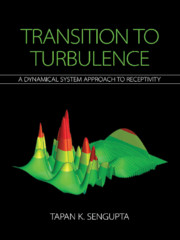Book contents
- Frontmatter
- Dedication
- Contents
- Preface
- 1 Receptivity, Instability, and Transition: A Perspective
- 2 Dynamical System Theory and Role of Equilibrium Flows
- 3 Fundamentals of Scientific Computing
- 4 Instability and Transition
- 5 Receptivity Analysis: Relation with Instability Experiments
- 6 Dynamical System Theory of Linear Receptivity
- 7 Nonlinear, Nonparallel Effects on Receptivity, Instability, and Transition
- 8 Three-Dimensional Routes of Transition to Turbulence
- 9 Receptivity to Free Stream Excitation: Theory, Computations, and Experiments
- 10 Nonlinear Receptivity Theories: Hopf Bifurcations and Proper Orthogonal Decomposition for Instability Studies
- 11 Mixed Convection Flow
- 12 Baroclinic Instability: Rayleigh–Taylor Instability
- 13 Coherent Structure Tracking in Transitional and Turbulent Flows
- 14 The Route of Transition to Turbulence: Solution of Global Nonlinear Navier–Stokes Equation
- References
Preface
Published online by Cambridge University Press: 16 February 2021
- Frontmatter
- Dedication
- Contents
- Preface
- 1 Receptivity, Instability, and Transition: A Perspective
- 2 Dynamical System Theory and Role of Equilibrium Flows
- 3 Fundamentals of Scientific Computing
- 4 Instability and Transition
- 5 Receptivity Analysis: Relation with Instability Experiments
- 6 Dynamical System Theory of Linear Receptivity
- 7 Nonlinear, Nonparallel Effects on Receptivity, Instability, and Transition
- 8 Three-Dimensional Routes of Transition to Turbulence
- 9 Receptivity to Free Stream Excitation: Theory, Computations, and Experiments
- 10 Nonlinear Receptivity Theories: Hopf Bifurcations and Proper Orthogonal Decomposition for Instability Studies
- 11 Mixed Convection Flow
- 12 Baroclinic Instability: Rayleigh–Taylor Instability
- 13 Coherent Structure Tracking in Transitional and Turbulent Flows
- 14 The Route of Transition to Turbulence: Solution of Global Nonlinear Navier–Stokes Equation
- References
Summary
The subject of this book has kept fluid dynamicists occupied for nearly two centuries, ever since the governing equation for fluid motion was developed by C. L. Navier and G. G. Stokes. While mathematicians are concerned with exploring the existence and uniqueness of a solution to the Navier–Stokes equation, physicists are fascinated by the fact that some “exact” laminar solutions are not observable. Early pioneers attributed this facet of the solution to the lack of stability of such exact or equilibrium solutions. This is how instability of fluid flows became a major subject of investigation, with near-unanimity among scientists that base flow is capable of feeding omnipresent background disturbances leading to transition.
As there are many equilibrium flows, the routes by which disturbances grow can also be vastly different. For example, the classical pipe flow experiment of Osborne Reynolds demonstrated that the transition of laminar flow to seemingly chaotic turbulent flow depends on the flow velocity and size of the pipe. Thus, the experiment highlighted the relationship of the instability with physical parameters. Now we know that the transition to turbulence in pipe flow depends upon the Reynolds numbers and background disturbances. The fact that quantitative description of transition to turbulent pipe flow still eludes us will encourage potential readers to embark upon research in this challenging field.
One of the early forays in flow instability studies has been the development of the eigenvalue analysis. It was adopted by Kelvin and Helmholtz to qualitatively explain interfacial instabilities such as those arising during the creation of surface gravity waves in lakes and oceans. The eigenvalue analysis remains the pedagogical tool to explain the phenomenon of instability and introduce the dispersion relation between spatial and temporal scales. In a similar vein of studying disturbance growth as an inviscid phenomenon, with equal ingenuity, Rayleigh developed the governing stability equation and a theorem to explain instabilities for jets afflicted by temporally growing disturbances. The failure of this inviscid theory in explaining flow over a flat plate prompted the development of viscous linear instability theory, known as the Orr–Sommerfeld equation. From the wave-like solutions obtained from this equation grow, in space, the well-known Tollmien–Schlichting (TS) waves.
- Type
- Chapter
- Information
- Transition to TurbulenceA Dynamical System Approach to Receptivity, pp. xvii - xxiiPublisher: Cambridge University PressPrint publication year: 2021



